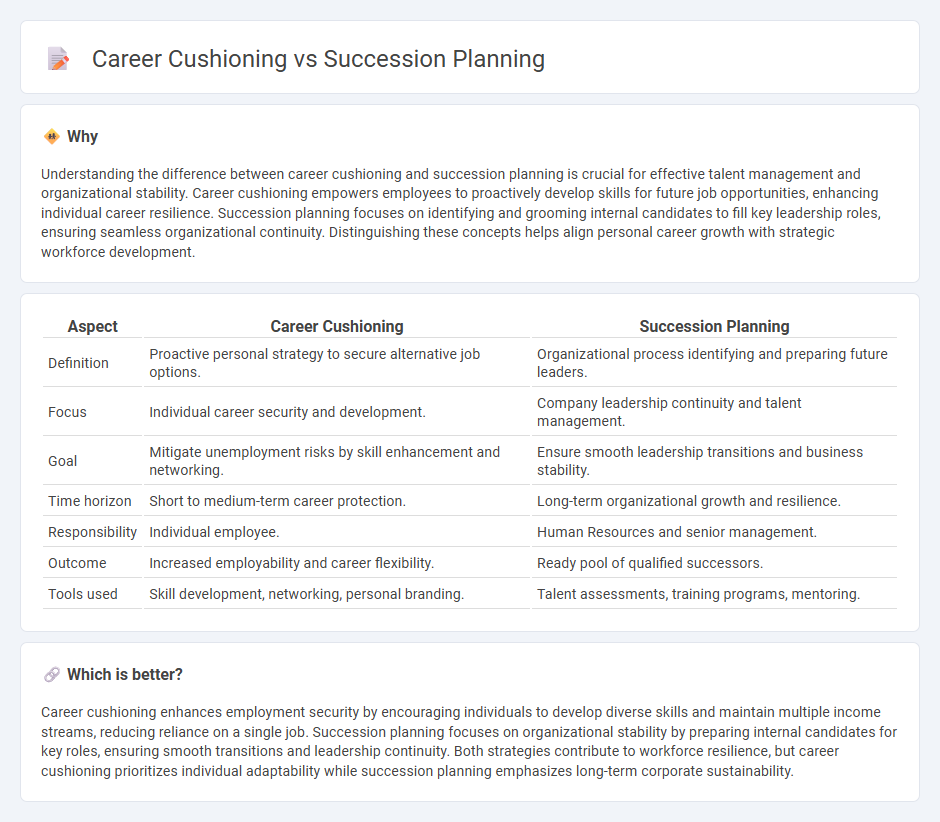
Career cushioning involves proactive steps employees take to secure future job opportunities and financial stability amid uncertain job markets. Succession planning is a strategic process organizations use to identify and develop internal talent for key leadership roles to ensure business continuity. Explore how both approaches play distinct yet complementary roles in workforce development and career security.
Why it is important
Understanding the difference between career cushioning and succession planning is crucial for effective talent management and organizational stability. Career cushioning empowers employees to proactively develop skills for future job opportunities, enhancing individual career resilience. Succession planning focuses on identifying and grooming internal candidates to fill key leadership roles, ensuring seamless organizational continuity. Distinguishing these concepts helps align personal career growth with strategic workforce development.
Comparison Table
| Aspect | Career Cushioning | Succession Planning |
|---|---|---|
| Definition | Proactive personal strategy to secure alternative job options. | Organizational process identifying and preparing future leaders. |
| Focus | Individual career security and development. | Company leadership continuity and talent management. |
| Goal | Mitigate unemployment risks by skill enhancement and networking. | Ensure smooth leadership transitions and business stability. |
| Time horizon | Short to medium-term career protection. | Long-term organizational growth and resilience. |
| Responsibility | Individual employee. | Human Resources and senior management. |
| Outcome | Increased employability and career flexibility. | Ready pool of qualified successors. |
| Tools used | Skill development, networking, personal branding. | Talent assessments, training programs, mentoring. |
Which is better?
Career cushioning enhances employment security by encouraging individuals to develop diverse skills and maintain multiple income streams, reducing reliance on a single job. Succession planning focuses on organizational stability by preparing internal candidates for key roles, ensuring smooth transitions and leadership continuity. Both strategies contribute to workforce resilience, but career cushioning prioritizes individual adaptability while succession planning emphasizes long-term corporate sustainability.
Connection
Career cushioning and succession planning are interconnected strategies that enhance organizational stability and employee growth by preparing individuals for future roles. Career cushioning empowers employees to develop transferable skills and build professional networks, creating a pool of capable candidates for succession planning. Succession planning leverages this preparation by identifying and nurturing high-potential talent to ensure seamless leadership transitions and sustained business continuity.
Key Terms
Succession Planning:
Succession planning strategically identifies and develops internal talent to fill key leadership roles, ensuring organizational continuity and minimizing disruptions during transitions. It involves systematic assessment of skills gaps, tailored training programs, and alignment with long-term business goals to maintain a robust leadership pipeline. Explore detailed strategies and best practices to implement effective succession planning in your organization.
Talent Pipeline
Succession planning targets identifying and developing internal candidates to fill key leadership roles, ensuring a robust talent pipeline that supports long-term organizational stability. Career cushioning emphasizes individual employees building diverse skills and networks to enhance personal job security and career mobility. Explore how combining these strategies can optimize talent pipeline resilience and organizational growth.
Leadership Development
Succession planning strategically identifies and prepares high-potential leaders to ensure organizational continuity and sustained leadership excellence. Career cushioning involves individuals proactively developing diverse skills and networks to safeguard against career disruptions, enhancing personal leadership resilience. Explore the distinctions and benefits of these approaches to optimize leadership development in your organization.
Source and External Links
Succession Planning: All You Need To Know [2025 Edition] - AIHR - Succession planning is the process of selecting and developing key talent to ensure continuity of critical roles, involving steps like creating a succession chart, identifying key positions, and assessing current talent.
Succession Planning: 7-Step Guide & Template - Paylocity - Succession planning is a long-term strategy that identifies and develops employees to replace key roles, ensuring business continuity and preparing the organization for future leadership needs.
Succession planning - Wikipedia - Succession planning is a strategy for identifying and developing potential leaders to fill key roles when they become vacant, often involving advisors to support smooth leadership transitions, especially in family businesses.
 dowidth.com
dowidth.com